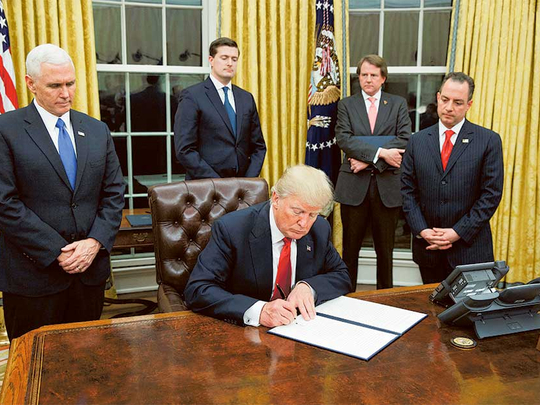
Washington: In his first executive order, President Donald Trump on Friday directed government agencies to scale back as many aspects of the Affordable Care Act as possible, moving within hours of being sworn in to fulfill his pledge to eviscerate Barack Obama’s signature health care law.
The one-page order, which Trump signed in a hastily arranged Oval Office ceremony shortly before departing for the inaugural balls, gave no specifics about which aspects of the law it was targeting. But its broad language gave federal agencies wide latitude to change, delay or waive provisions of the law that they deemed overly costly for insurers, drugmakers, doctors, patients or states, suggesting that it could have wide-ranging impact, essentially allowing the dismantling of the law to begin even before Congress moves to repeal it.
The order states what Trump made clear during his campaign: that it would be his administration’s policy to seek the “prompt repeal” of the health insurance law, known as Obamacare. But he and Republicans on Capitol Hill have not yet devised a replacement, making such action unlikely in the immediate term.
“In the meantime,” the order said, “pending such repeal, it is imperative for the executive branch to ensure that the law is being efficiently implemented, take all actions consistent with law to minimise the unwarranted economic and regulatory burdens of the act, and prepare to afford the states more flexibility and control to create a more free and open health care market.”
The order has symbolic as well as substantive significance, allowing Trump to claim he acted immediately to do away with a health care law he has repeatedly called disastrous, even while it remains in place and he navigates the politically perilous process of repealing and replacing it.
Using the phrase, “to the maximum extent permitted by law,” the order directs federal agencies to move decisively to implement changes, including granting flexibility that insurers and states had long implored the Obama administration to provide.
The order says that federal officials should do everything they can to encourage “a free and open market in inter-state commerce for the offering” of health insurance and health care. Under this directive, officials could promote the sale of insurance across state lines, which Republicans have long proposed as the centrepiece of an alternative to the law.
“This action demonstrates that President Trump is committed to fixing the damage caused by Obamacare as soon as possible,” said Senator John Barrasso, Republican from Wyoming.
The order does not direct the Department of Health and Human Services to ease any particular aspect of the 2010 law, but it could result in a substantial weakening of one of its central features: the individual mandate that requires most Americans to have health insurance or pay a tax penalty.
While the Obama administration allowed “hardship exemptions” to the mandate, the Trump administration could conceivably interpret the requirement in a more lenient way, so that more people would not be penalized.
Likewise, federal officials could be more receptive to state requests for waivers under Medicaid, the federal-state program that covers more than 70 million low-income people. A number of Republican governors and state legislators would like to charge higher premiums or co-payments than are now allowed. Some states want to provide a less generous, less expensive package of benefits, or require some able-bodied adults to work as a condition of receiving Medicaid.
On a day when many congressional Democrats attended the inauguration wearing blue buttons on their lapels that said #ProtectOurCare, Trump’s action was greeted with fury by advocates working to preserve Obama’s law.
“The president’s executive order combined with the strategy of the congressional Republican leadership to rush ahead with repeal with no viable replacement plan will result in taking insurance away from tens of millions of Americans, raising premiums for millions more, and threatening one-sixth of the US economy,” said Leslie Dach, the director of the Protect Our Care Coalition.
While Trump’s directive allows officials to take steps that would increase costs for consumers, that result is not inevitable. Indeed, the order says officials should try to reduce costs and burdens on consumers.
Over the past six years, insurance company executives have bitterly complained that federal insurance regulations were extremely prescriptive and onerous. By relaxing some of those rules, the Trump administration could make the individual insurance market more attractive to insurers. And insurers might then be more willing to stay in or return to the public marketplaces established under the Affordable Care Act.
In the past year, a number of insurers have dropped out of those markets, leaving consumers with fewer health plans to choose from.
House Republican leaders recently asked governors for recommendations on health policy, and governors from both parties said the federal government should scale back its regulation of health insurance.
Governor Bill Haslam of Tennessee, a Republican, said this month that federal officials should “reconsider the premise that health insurance public policy should be directed from Washington.”
He said federal rules for setting insurance rates and defining “essential health benefits” should be more flexible.












